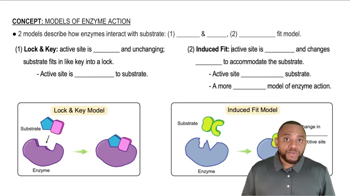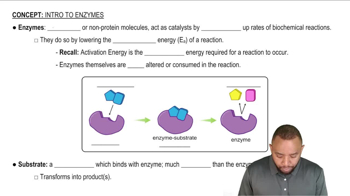Here are the essential concepts you must grasp in order to answer the question correctly.
Lock-and-Key Model
The lock-and-key model of enzyme action proposes that enzymes and substrates fit together perfectly, much like a key fits into a lock. This model suggests that the enzyme's active site is rigid and specifically shaped to accommodate a particular substrate, leading to a precise interaction. This concept emphasizes the specificity of enzymes for their substrates, which is crucial for understanding enzyme catalysis.
Recommended video:
Models of Enzyme Action Example 1
Induced-Fit Model
The induced-fit model expands on the lock-and-key concept by suggesting that the active site of an enzyme is flexible and can change shape upon substrate binding. This adaptability allows for a more dynamic interaction, enhancing the enzyme's ability to catalyze reactions. The induced-fit model highlights the importance of conformational changes in enzyme activity and substrate specificity.
Recommended video:
Models of Enzyme Action Concept 1
Enzyme Catalysis
Enzyme catalysis refers to the process by which enzymes accelerate chemical reactions in biological systems. Enzymes lower the activation energy required for reactions, allowing them to occur more readily. Understanding the mechanisms of enzyme catalysis, including the differences between the lock-and-key and induced-fit models, is essential for grasping how enzymes function and their role in metabolic pathways.
Recommended video:
Intro to Enzymes Concept 1
 Verified step by step guidance
Verified step by step guidance


